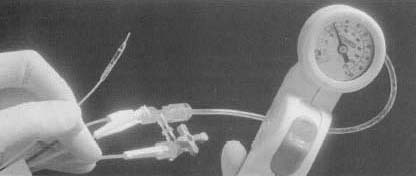Angioplasty, balloon
Balloon angioplasty is a medical technique used to widen coronary (heart) arteries that have been narrowed by plaque (fatty material) deposits that cling to the inside of the artery walls. In a coronary (heart) disease called atherosclerosis ("hardening of the arteries"), the arteries become so dangerously clogged that surgery is required to clear the blockage. If left untreated, atherosclerosis can lead to complications like angina, a condition that causes suffocating heart pain.
Historical Angioplasty
The first step toward relief of atherosclerosis was the invention of cardiac (heart) catheterization (a method for draining harmful fluid build-up). The catheterization procedure was invented by German physician Werner Forssmann (1904-1979) in 1929. Experimenting on himself, Forssmann found a way to thread a catheter (a long, thin, flexible tube) through an arm vein all the way into the heart. In 1958 Mason Sones invented selective coronary arteriography, an x-ray procedure in which dye is injected into the arteries. This allows physicians to use X-ray photography to follow the path of the dye through the body. In 1964 Charles T. Dotter and Melvin Judkins of the University of Oregon (Eugene) combined these advances to successfully perform transluminal (along the "lumen," or cavity, of a blood vessel) angioplasty (blood vessel repair). Dotter and Judkins unclogged leg arteries with a fluoroscope (an instrument used for examining the internal structure of an opaque object), which guided a catheter along the artery and dilated (open up) the blocked area.
Swiss Angioplasty Procedure Performed
At the University Hospital in Zurich, Switzerland, Andreas Gruentzig was especially interested in whether the catheterization procedure could be used to clear blockage in the relatively small coronary arteries, the blood vessels that feed the heart. First he added a balloon to the catheter. The balloon-tipped catheter was inserted into the partially blocked portion of an artery. The balloon was then inflated (blown up), which pushed the fatty plaque back against the inner blood vessel walls. Thus the artery was opened, greatly improving blood circulation. Gruentzig then miniaturized the balloon catheter for use in coronary arteries. On September 16,1977, Gruentzig performed the first coronary balloon angioplasty on a human patient. Gruentzig's surgical team was surprised at the ease of the procedure.
Angioplasty, also known as "Percutaneous Transluminal Coronary Angioplasty" (PTCA), rapidly came into widespread use around the world as a relatively simple, inexpensive, and safe alternative to coronary bypass surgery (a major operation that requires cutting open the patient's chest and usually a leg, from which a vein is harvested, or taken, to be used in the bypass). In contrast, angioplasty presents fewer risks while it saves the arms, legs, and kidneys affected by the impaired circulation.
There has been growing concern, however, about a buildup in the arteries called restenosis that often appears in patients who have undergone balloon angioplasty. A new technique, pioneered by several groups of researchers in the early 1980s, combines lasers with the catheter. The laser vaporizes plaque in arteries, then balloon angioplasty finishes the opening of the blood vessel. Laser angioplasty is currently approved for use in leg arteries only. One drawback is that laser angioplasty carries a significant

[See also Angiography, Coronary ; Laser surgery ]
Thank you!
With CABG you will have general anaesthesia and will need to recover for about 1 to 2 days in the intensive care unit, possibly on a ventilator, recovery from when you leave hospital can take many weeks. The procedure as I mentioned is open-heart. CABG involves significantly more risk than angioplasty. These risks include complications during and after surgery, such as internal bleeding or infection.
CABG is only recommended when the benefits outweigh the risks
Source(s):
Cardiac Nurse
]